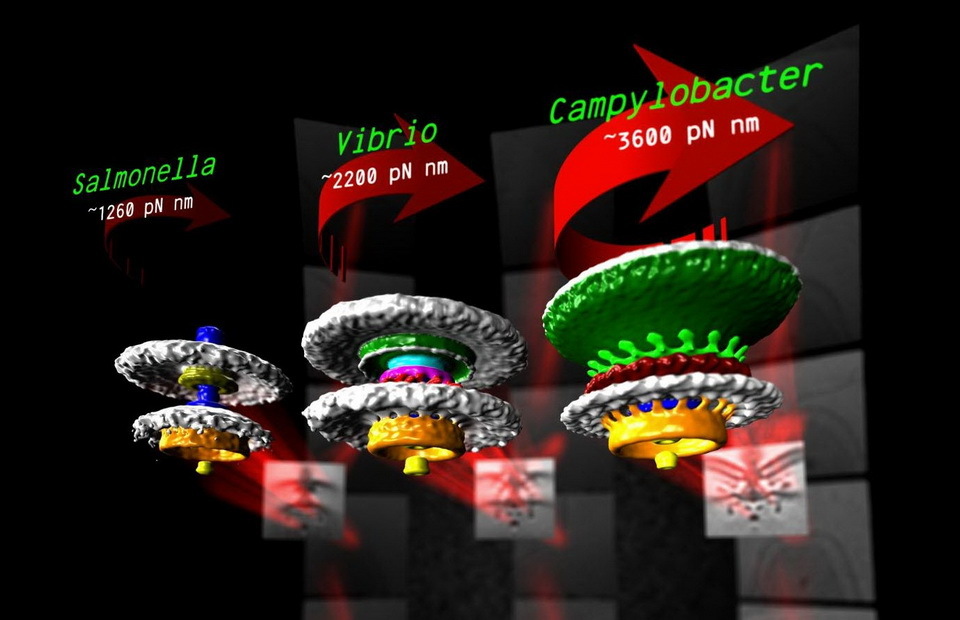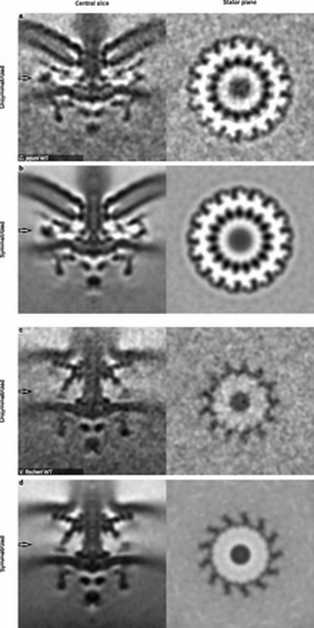High-quality images were obtained, a 3D-model was created and the mechanism of action of nano-sized bacteria biomotors was analyzed.
Welcome to the pages of the blog iCover! As you know, some types of microorganisms move due to their rapidly rotating flagella, the source and mechanism of movement of which has long given no rest to the scientific world. But scientists didn’t succeed in understanding and, moreover, visualizing the hidden mechanisms of such a movement until now. A real breakthrough that made it possible to fill the information vacuum and clarify the main structural features of the biological engine of bacteria was the study of a group of specialists from Imperial College in London under the direction of Morgan Beeby. Using the technology of 3D-electron cryotomography (electron cryotomography), scientists were able to obtain high-quality images of natural bio-engines of microorganisms, to identify analogies and differences with the engines, invented by man,

The difference in motor abilities of various microorganisms, some of which are literally “drilled” with their screw “flagella propellers”, viscous body fluids (gastrointestinal mucus, etc.), while others are almost immobilized, prompted scientists to think that bacteria have their own internal biological engine with well-defined, limited and measurable torque characteristics. To confirm their hypothesis, scientists conducted an interesting experiment using cryotomography technology.
The principle used in electronic 3D cryotomography is fairly simple to understand. The test samples, cooled to a certain temperature, are placed under the electron microscope socket. The almost complete immobility of the molecular structure at low temperatures allowed the Morgan Bibi group to capture a whole collection of photos of the biological engines of the Campylobacter Jejuni, Salmonella Tyhimurium and Vibrio Fischeri bacteria from different angles. The collected collection of unique images allowed scientists to recreate a three-dimensional model of the biological engine of the bacteria of the three above-mentioned species.

High-torque bacterial flagellar motors assemble large periplasmic disk groups. (A – C) Tomographic slices of Salmonella (A), V. fischeri (B), and C. jejuni © showing individual flagellar motors. Height of all image panels is 100 nm. (D – F) Slices (100 × 100 × 0.81 nm) through subtomogram averages of hundreds of motors. Color keys (of G – I), of Salmonella (average of 286 motors) (D), V. fischeri (average of 302 motors) (E), and C. jejuni (average of 156 motors ) (F). (G – I) Isosurface renderings of motors shown in D – F. FliI and FlhAC are components of the flagellar type III secretion system.
The experiments carried out demonstrated a surprising fact: despite the similarity of the general principles of operation, the microbiological engines of each type of microorganism are unique. Differences are recorded both at the level of size and performance, and at the level of form, complexity of the mechanism, torque values and many other parameters that directly and indirectly affect the operation of biotromotors. At the same time, the fixed rings-disks, which perform the role similar to the electric motor stator, turned out to be a common structural element for all types. It is thanks to them that the biomotor produces a certain torque, which sets in motion all kinds of flagella, the “propellers” of the bacterium, which move it in the right direction with the optimum speed and force for a given medium.
The absolute leader in terms of size, complexity, design and magnitude of torque within the experiment was the engine of the Campylobacter bacterium, the diameter of the disk-stator which is twice as large as that of the Salmonella bacterium. It is characteristic that the designs are different not only in size, but also in the number of disks.

Unsymmetrized motors showing clear symmetries. C. jejuni motors (A, Left) exhibited a 17-fold symmetry (A, Right). V. fischeri exhibited 13-fold symmetry ©, which has been to improve the signal-to-noise ratio (D).
Scientists have come to another very interesting conclusion, finding a direct relationship between the maximum level of energy produced and the specificity of the “mission” that a bacterium or virus performs in the body. So, for example, the energy produced by the Campylobacter biological engine is enough to make excursions within the intestinal environment of a living organism, where the bacteria live and function, but not enough to penetrate through its walls. According to scientists, the variety of forms and sizes of biological engines, united by a single principle of action, testifies in favor of the antiquity of the origin of the discovered mechanism.
Scientists were also able to determine the protein components of the structural elements of the engine and the sequence of their assembly, justifying the functional purpose of each of the elements for the operation of the entire biological device. “The quantitative results of studies of biowotors with different torques allowed us to clearly define the purpose of the main components of this biological structure and remove a number of important limitations on the way to understanding the mechanisms of torque generation and evolution of multiprotein complexes,” the publication says.
Research conducted by scientists and the results obtained are of crucial practical importance, since they open up fundamentally new opportunities for creating nanorobots that need to achieve their goals in autonomous “engines” with strictly defined parameters and technical characteristics. In other words, having a database of natural biological engines with the desired characteristics, specialists working in the field of nano-robotics will be able to create any desired artificial nano-analogue simply by selecting and copying the necessary option from the database, proposed by nature itself. .
Source newscientist.com
Anyone who wants to get acquainted with the results of the experiment will be invited to pnas.org
Dear readers, we are always happy to meet and wait for you on the pages of our blog. We are ready to continue to share with you the latest news, review materials and other publications, and will try to do everything possible so that the time spent with us will be useful for you. And, of course, do not forget to subscribe to our headings .
Our other articles and events

The difference in motor abilities of various microorganisms, some of which are literally “drilled” with their screw “flagella propellers”, viscous body fluids (gastrointestinal mucus, etc.), while others are almost immobilized, prompted scientists to think that bacteria have their own internal biological engine with well-defined, limited and measurable torque characteristics. To confirm their hypothesis, scientists conducted an interesting experiment using cryotomography technology.
The principle used in electronic 3D cryotomography is fairly simple to understand. The test samples, cooled to a certain temperature, are placed under the electron microscope socket. The almost complete immobility of the molecular structure at low temperatures allowed the Morgan Bibi group to capture a whole collection of photos of the biological engines of the Campylobacter Jejuni, Salmonella Tyhimurium and Vibrio Fischeri bacteria from different angles. The collected collection of unique images allowed scientists to recreate a three-dimensional model of the biological engine of the bacteria of the three above-mentioned species.

High-torque bacterial flagellar motors assemble large periplasmic disk groups. (A – C) Tomographic slices of Salmonella (A), V. fischeri (B), and C. jejuni © showing individual flagellar motors. Height of all image panels is 100 nm. (D – F) Slices (100 × 100 × 0.81 nm) through subtomogram averages of hundreds of motors. Color keys (of G – I), of Salmonella (average of 286 motors) (D), V. fischeri (average of 302 motors) (E), and C. jejuni (average of 156 motors ) (F). (G – I) Isosurface renderings of motors shown in D – F. FliI and FlhAC are components of the flagellar type III secretion system.
The experiments carried out demonstrated a surprising fact: despite the similarity of the general principles of operation, the microbiological engines of each type of microorganism are unique. Differences are recorded both at the level of size and performance, and at the level of form, complexity of the mechanism, torque values and many other parameters that directly and indirectly affect the operation of biotromotors. At the same time, the fixed rings-disks, which perform the role similar to the electric motor stator, turned out to be a common structural element for all types. It is thanks to them that the biomotor produces a certain torque, which sets in motion all kinds of flagella, the “propellers” of the bacterium, which move it in the right direction with the optimum speed and force for a given medium.
The absolute leader in terms of size, complexity, design and magnitude of torque within the experiment was the engine of the Campylobacter bacterium, the diameter of the disk-stator which is twice as large as that of the Salmonella bacterium. It is characteristic that the designs are different not only in size, but also in the number of disks.

Unsymmetrized motors showing clear symmetries. C. jejuni motors (A, Left) exhibited a 17-fold symmetry (A, Right). V. fischeri exhibited 13-fold symmetry ©, which has been to improve the signal-to-noise ratio (D).
Scientists have come to another very interesting conclusion, finding a direct relationship between the maximum level of energy produced and the specificity of the “mission” that a bacterium or virus performs in the body. So, for example, the energy produced by the Campylobacter biological engine is enough to make excursions within the intestinal environment of a living organism, where the bacteria live and function, but not enough to penetrate through its walls. According to scientists, the variety of forms and sizes of biological engines, united by a single principle of action, testifies in favor of the antiquity of the origin of the discovered mechanism.
Scientists were also able to determine the protein components of the structural elements of the engine and the sequence of their assembly, justifying the functional purpose of each of the elements for the operation of the entire biological device. “The quantitative results of studies of biowotors with different torques allowed us to clearly define the purpose of the main components of this biological structure and remove a number of important limitations on the way to understanding the mechanisms of torque generation and evolution of multiprotein complexes,” the publication says.
Research conducted by scientists and the results obtained are of crucial practical importance, since they open up fundamentally new opportunities for creating nanorobots that need to achieve their goals in autonomous “engines” with strictly defined parameters and technical characteristics. In other words, having a database of natural biological engines with the desired characteristics, specialists working in the field of nano-robotics will be able to create any desired artificial nano-analogue simply by selecting and copying the necessary option from the database, proposed by nature itself. .
Source newscientist.com
Anyone who wants to get acquainted with the results of the experiment will be invited to pnas.org
Dear readers, we are always happy to meet and wait for you on the pages of our blog. We are ready to continue to share with you the latest news, review materials and other publications, and will try to do everything possible so that the time spent with us will be useful for you. And, of course, do not forget to subscribe to our headings .
Our other articles and events
- Gator Caref Watch. Caring for your child
- Spring discounts from KitchenAid
- Sale of useful gadgets and interesting pieces
- Logitech Expands Color-Illuminated Mechanical Gaming Keyboards
- A selection of smart watches today. What changed?
- Perfect gadget backpack for father family
- How the case did not save my iPhone. Choose right
